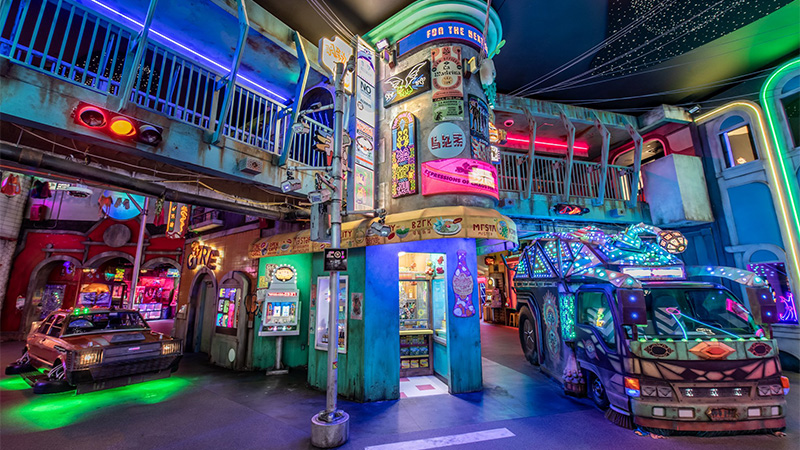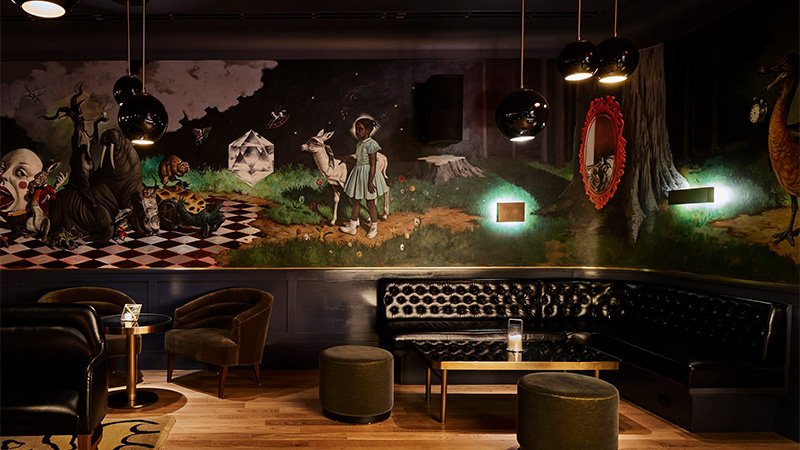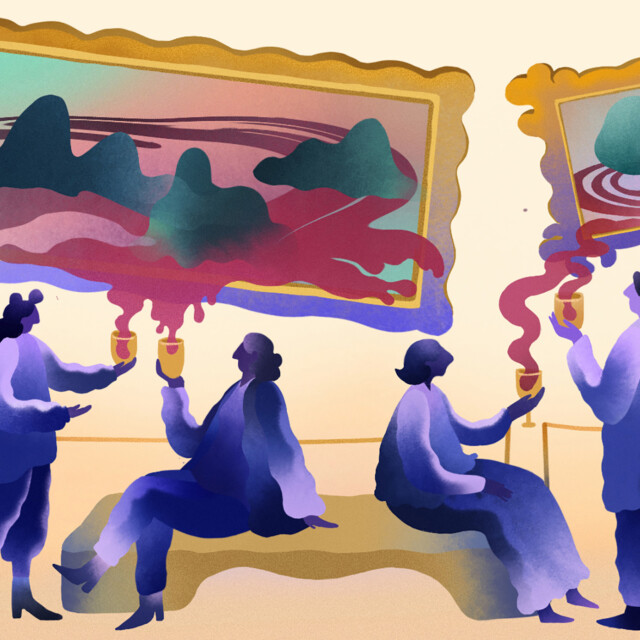Museums and art exhibitions are always mildly improved with alcohol. Typically, to motivate people to attend a new opening or to stop into an art exhibition, organizers know that the promise of supermarket cheese and cheap sparkling wine can help draw crowds. They know that no matter how interesting an artifact or beautiful a painting, museum-goers will end up huddling around the communal table with the boxed Chardonnay and dry crackers. These inferior drinks and foods sometimes seem like the greatest draw; when the food is picked over and the bladders and bottles are emptied, much of the crowd often departs.
But a few museums, art exhibitions, and spaces hosting powerful murals have found ways to make drinks a vital part of the experience. While these establishments know that people might tune out museum docents or skip a piece of art because it doesn’t speak to their souls, they also know that using beverages is another way to tell their stories.
Museums
The American Prohibition Museum in Savannah, Ga., features exhibits on everything from the Temperance Movement to rum-running to moonshine-making. While that’s exactly what one would expect from a museum that explores the worlds between illegal tippling and irritated teetotalers, a trip to a museum about the prohibition of drinks is guaranteed to make some guests thirsty. Fortunately, after an early evening of exploring the museum, visitors can sneak around back to the museum’s built-in speakeasy at Congress Street Up. The space feels like a 1920s secret bar with its tin punch ceiling, parquet floors, costumed bartenders, period music, illicit ambiance, and exceptional drinks.

To properly learn about spirits and drinks — without having to read about them on some museum sign or study some locked-away bottle — the speakeasy hosts Tuesday night whiskey classes, Thursday night tequila classes, and near-nightly cocktail seminars, where students can actually drink as they soak in the knowledge.
“Through the classes, we hope to introduce guests to spirits and cocktails they may have never heard of or tried before,” says Jason Graham, bar manager at Congress Street Up. “We focus more on challenging guests to explore outside of their usual scope.”
At the whiskey class, for instance, which Graham often leads, he speaks of the spirit’s history and distilling process while seven whiskeys are served to guests blind — an activity that can boost or dampen one’s ego as everyone is forced to guess the whiskey style, often to their chagrin.
But it’s also story hour, and tales are told of the industry, like how one distillery tries to influence its whiskeys by playing Metallica to its barrels so that the liquid inside moves to the pulsing soundtrack and takes on different qualities from the barrel.
Art Experiences
Santa Fe’s landscape features brown adobe architecture that blends seamlessly into the brown hues of the high desert. From an airplane, much of the city disappears. But the one thing you might see at 30,000 feet is Meow Wolf, which does anything but blend in.
Meow Wolf started as a collective of young Santa Fe artists who were searching for a creative outlet. In the beginning, it hosted warehouse parties that doubled as art installations. When the author George R. R. Martin, whose fantasy novels inspired “Game of Thrones,” bought an old bowling alley, he essentially created another fantastical universe. By opening it up to these artists, Meow Wolf: House of Eternal Return was born
Meow Wolf is a choose-your-own-adventure experience that dives deep into a fictional narrative about a time hiccup that opened a multiverse and caused one family a calamity. Visitors enter the house, find clues to uncover what happened to the family, and then slip through portals — the fireplace and dryer and refrigerator are all wormholes — that lead to the multiverse, where each room is itself a gorgeous, bizarre, and mind-boggling piece of art.
Guests are either overstimulated after 20 minutes, or become so consumed by the story that they’ll invest seven hours to uncover the entirety of the plot. Regardless, after one exits the House of Eternal Return, they could often use a drink.
In the lobby, beneath jumbo-sized crystal ball bowling pins and trinkets that look like medicinal Lucky Charms, guests can stop at Meow Wolf’s Float Bar, which serves drinks that are as trippy as the exhibit, but at least take off the edge. The Meowgarita, for example, is topped with a cloud of cotton candy and is made with butterfly pea flower tea that, when combined with lime juice, transforms from green to lavender. Float Bar also serves Ghost Day, a Japanese-style rice lager that Marble Brewery created for the museum.
“The known world slips away when Day Ghost is uploaded to your bodily machine,” the can says, as if it were birthed during the time hiccup. “Clouds part, new realities bubble, and an inner vista is revealed.”
On the first Thursday of every month, Meow Wolf hosts Adulti-verse, closing the exhibit to anyone under drinking age so that for four hours, guests 21 and over can explore the mind-bending exhibit with drinks from whatever beverage company takes over the tap or occupies the bar that day. This actually might be the best way for most people to handle House of Eternal Return, as a little mind-blunting from a beer or gin drink could help counter the beautiful and panic-inducing sensory overload inside.
Murals
In Washington D.C., off the museum-lined mall, Allegory, a dark and intimate cocktail lounge, hides within Eaton D.C.’s lobby. Entering Allegory feels a bit like falling down a rabbit hole, which was the intention of the artist, Erik Thor Sandberg, who designed the mural lining the walls. Inspired by a Norman Rockwell painting of civil rights activist Ruby Bridges, Sandberg’s version — which covers all of Allegory’s walls — places Bridges not in Louisiana desegregating an all-white school, but in some alternate version of Wonderland. In the paintings, Bridges walks past characters that could have been Lewis Carroll creations — a half-crab, half-hippo, a deer with bat wings, a fox-headed snake — to eventually battle with the infamous Jabberwock.

Behind the bar, a team of mixologists complements the mural’s story with drinks they’ve dreamed up and created as chapters in Allegory’s menu, titled down the rabbit hole.
Deke Dunn, the head mixologist and visionary behind the menu, tells two stories in the menu’s 12 chapters (which mimic the chapter count of “Through the Looking-Glass”). The left side of the menu reads like a Ruby Bridges children’s book that uses quotes taken from actual Bridges interviews. The right side features Sandberg’s sketches of “Ruby in Wonderland” along with cocktails that speak to the art and chapter’s story.
For instance, chapter seven, All Blood Runs Red, is when Ruby learns why the other children won’t play with her. Paired with an illustration of Ruby standing over a slain Jabberwock, the chapter ends with Jabberywocky Part Dos, a complex bourbon drink mixed with Abasolo, El Salvadorian amaro, pineapple, jacote (which is similar to a plum), nance, and Campari dust.
Beneath the ingredients is a credit to the mixologist — “Dreamed by Julio Zavala” — and a one-liner to explain the cocktail in layman’s terms. “It democratizes cocktails a bit,” Dunn says, “to avoid making people feel stupid.”
But inside Allegory, everyone just feels mesmerized by the art and blown away by the cocktails.
